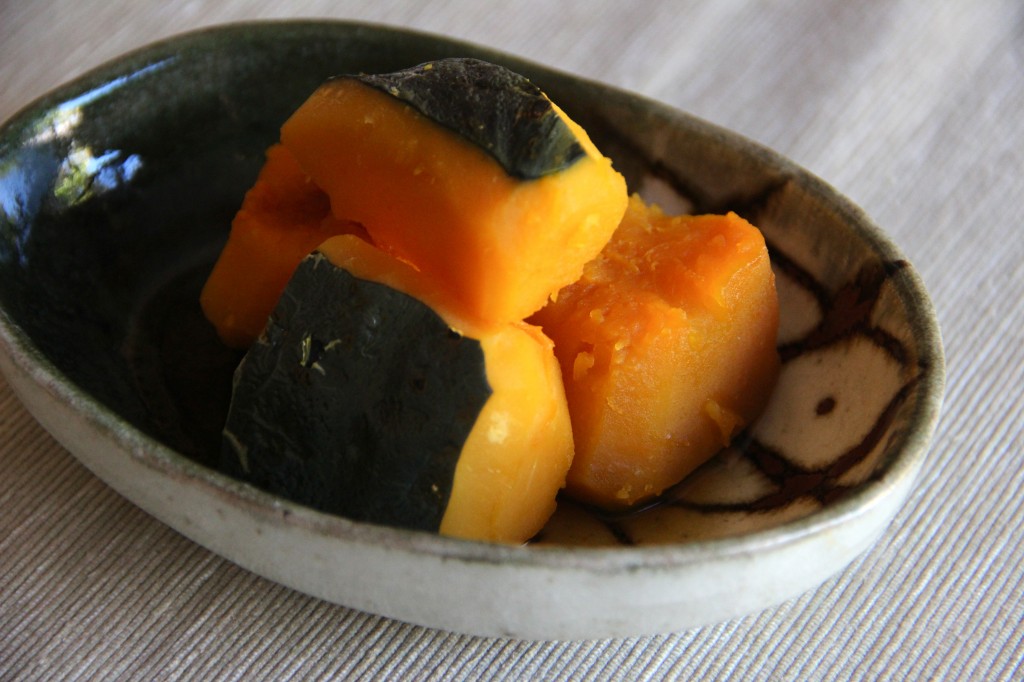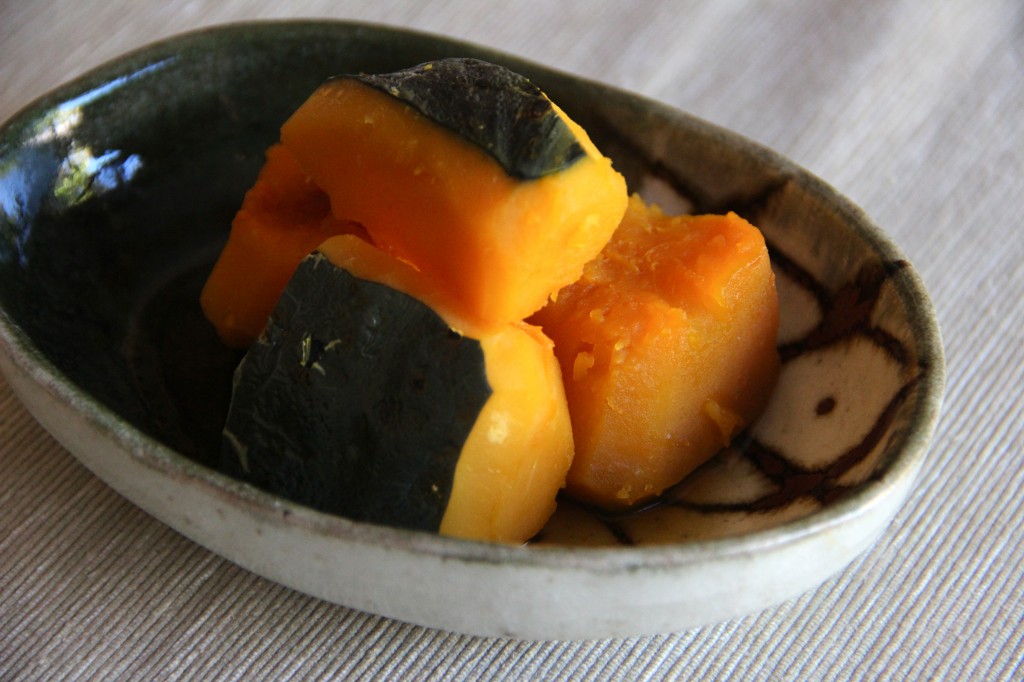Nimono is usually seasoned with combinations of soy sauce, sugar, Sake or Mirin that give vegetables sweet and salty flavors. The seasoned broth in Nimono is not soup to drink, but only to give vegetables flavoring. It gives mild flavorings to vegetables and enhances the taste of the vegetables.
Japanese pumpkin, Kabocha, is very dense and sweet, different from pumpkin in the US. In Japan, Kabocha is in season in winter, and this dish reminds me of winter time there. When Kabocha is cooked, the inside becomes bright orange. Kabocha’s thick and dense texture is closer to sweet potatoes than squash. Kabocha no Nimono usually has a sweeter broth than some other kinds of Nimono. But you can change to your liking.
Kabocha is very hard to cut when it’s raw, so please be careful. First stab it with knife, then cut down. Trim the sharp edges of the rind from the cut pieces of Kabocha. That’s supposed to help Kabocha from dissolving, according to my mother.
If you like yam on Thanksgiving, you’d like this dish, just not as sweet. It could be a side dish to an American main dish such as roast chicken or meatloaf. Or with any kind of Japanese main dish, of course.
Kabocha is available at many supermarkets in the US.

Kabocha no Nimono (Simmered Pumpkin) Recipe
Instructions
- Remove seeds and cut Kabocha into 3″ square pieces. Cut off sharp edges of the Kabocha pieces.
- Boil Dashi in a pot and put Kabocha in it. Cook Kabocha covered until tender at medium heat, about 20-30 minutes depending on how hard your Kabocha is.
- Add sugar, soy sauce, salt and Sake to the Kabocha. Reduce heat to medium low, and cook another 15 -20 minutes to reduce the broth a little.
- Remove from heat and let it sit covered until cool. As it cools, Kabocha will absorb more of the flavor from the broth. If you like it warm, reheat before serving.
Video



21 Comments
Kabocha is one of our favorites, I don’t know if you can find it easily in the US? Aside from having it boiled (I sometimes use the microwave) we really like the Kabocha Salad which sometimes comes with a bento. かぼちゃのサラダ
Cheers, Happy Easter Weekend.
Kabocha Salad is really good too! We can find Kabocha at many supermarkets around here, well, at least we know in Southern California.
My dad grew kabocha pumpkins in the garden when I was going up and I think my mom made something similar to this and some times she would add Aburaage or these small dried fish (not flakes) to the kabocha. Would you be able to do that with this recipe?
Kiyomi san,
I love Kabocha with Aburaage, too!
Just tried this tonight and it was delicious! I didn’t have sake or dashi, so I used a bit of vegetable bouillon cube, mirin, and fish sauce, which worked really well. I even threw in some wasabi roasted seaweed from Trader Joes. A couple of weeks ago I tried to cook kabocha with a tomato sauce and it was alright but I think I got one that wasn’t ripe yet. I made sure to get a ripe one this time and this was so yummy!
A couple of tips: a ripe kabocha (sweeter) normally has some orange patches and may be grayer in color. The skin should be thick and the pumpkin should feel heavy for its size. Solid emerald green kabocha may still taste fine too but I like the riper/sweeter taste better.
A tip for cutting the kabocha: I just put mine in the oven at 400 degrees for 20 min so it is partially cooked. Then cutting it is super easy! You can also microwave it for a few minutes. When you continue to cook the kabocha for a meal, you’ll need less cooking time otherwise it will turn to mush. I half-cook it, cut it up, then keep it in the fridge to use as needed.
Amber,
Thanks for trying our Kabocha recipe! Keep on cooking!
I lived in Japan for eight years back in the 1960’s and love Japanese food including nimono. When I make kabocha nimono I always add a few grains of hon-dashi for extra flavor.
The secret of cutting raw kabocha is to have a sharp knife and be cautious. I worked as a meat cutter for about 30 years and can attest to the fact that a dull knife is much more dangerous that a sharp one. Most American kitchens are unfortunately equipped with dull ones so sharpen that knife but please, be careful.
Charlie,
thanks for your comment. Hon-dashi is convenient and good alternative to dashi, but try our real Dashi for your Nimono next time. I think you’ll like it!
Both the Asian and American supermarket near my house that had something called “East Squash”. It looked kind of like kabocha but without the green skin. Do you happen to know if this might be kabocha?
I just got back from living in Japan, and I really wanted to make some sort of kabocha dish.
Kristin,
sorry but have never heard of it. If you try, let us know!
if it had a bright orange/reddish skin and a bright orange interior it was probably a hokkaido pumpkin, known in Japan as Uchiki Kuri. If it had green skin but no defined light green stripes like kabocha, it was probably a blue ballet. Both work really well if you can’t find authentic Kabocha, since it’s barely available outside of east Asia.
I tried this recipe tonight (along with sesame broccoli and wasabi avocado salad) and it was just perfect!
It was my first try from Japanese Cooking 101 and I want to try everything: Anko, donburi, tonkatsu…!
I have no excuse now that I leave in Singapore I found more asian ingredient than in my hometown in France!
The only recipe I still haven’t found anywhere is the special Ichigo Daifuku that I’ve eaten in Yamagata when I was in ski holiday at Zao Onsen! They don’t use “normal” red Anko but the inside a kind of white paste! Any idea what this could be ;)?
Thanks for this incredible website! It’s a gem for all Japanese food lover like me 🙂
Alizee,
glad you liked many of our recipes. The white paste in Ichigo Daifuku must be white bean paste. We will add white bean paste recipe on our sites soon.
I saw kabocha in the local market and made this recipe. The smells and flavors remind me of growing up with my Japanese mother’s cooking in California. I am eager to try out your other recipes while I am far from home on the east coast. The layout of this website is very well done. Thank you for sharing all of this recipes.
Duncan,
Glad you liked our recipe! Come back again soon!
Hi! 🙂 – I don’t find sake. What could I use in place of it to make this recipe?
Fabio,
just omit sake.
Do you use concentrated dashi broth (like from the bottle) in this measurement?
Julia,
we don’t use instant Dashi, but you could if you wish.
My fiancee and I just tried this recipe and loved it! We had to experiment with the recipe a bit since I think the dashi we bought was concentrated (first time the flavor was too strong!). Do you have a recipe for making dashi at home?
Hi,
is it similar to change to Hokkaido?
Because this japanese pumpkin is easily available in Germany. It’s the most beloved pumpkin of germans now, perhaps it’s easy to prepare and tastes great and sweat and got that wonderful color. How you describe Kabocha it sounds the same for me